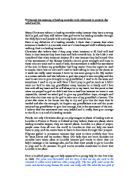The ‘Last Rites.’
In his steadfast love for us, the Lord gives us the sacraments involved in the last rites to comfort us in our final days and prepare us for the journey ahead. "These include penance (or confession), confirmation (when lacking), anointing of the sick . . . and Viaticum (which is meant to be the last reception of Communion for the journey from this life to eternity)
The most important part of the last rites is the reception of the Lord in one’s final Communion; also called "Viaticum" (Latin = that which you take on the road, i.e., provisions for a journey) This special Communion prepares us to travel with the Lord on the final part of our journey.
From the earliest times, the sacrament of the anointing of the sick was cherished among Christians, not only in immediate danger of death, but even at the beginning sign of danger from illness or old age.
Each sacrament has 2 sides – an outward visible side and an inward invisible side. All those present can see the outward side, while the inward side is spiritual and underlines the true significance of the event.
Illness often brings a crisis in a person’s life. For Catholics, the Sacrament of Anointing is a ceremony which gives them spiritual comfort and often recovery of health. The reason for this sacrament is found in the life of Christ who had a special care for the sick and told his follower to have the same concern. The effects of the sacrament are summarised as: spiritual comfort, forgiveness of sins and strengthening to face illness.
Even though we must face a certain amount of suffering and affliction in this life, we know God’s grace is sufficient to sustain us. All of God’s graces, including physical health, are bestowed to lead to the salvation of our souls. The Catholic Church teaches that the sacrament brings ‘ the restoration of health, if it is conducive to the salvation of his/her soul.’
The Sacraments name had changed over time and once used to be called extreme unction meaning ‘the last anointing.’
The Church expects the same effects for the sacrament of Anointing, as those seen in the life of Jesus in the Gospel. The following effects can be expected;
- The sick person receives the grace (love and power) of the Holy Spirit of God
- The sick are given strength and courage to accept illness.
- They are not anxious about death. When this fear is lifted, people often get well again.
- There is forgiveness of sin for the sick person.
- The prayer of faith has a most important effect for the sick person. James’ words are ‘The prayer made in faith, will heal the sick person.’ Healing in this sense is to be understood as strengthening to the whole person in body and mind. The healing is a spiritual victory over sickness.







